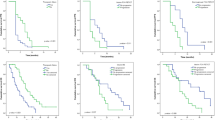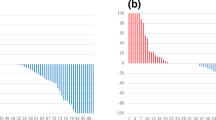Abstract
Background
Bone flare has been observed on 99mTc-MDP bone scans of patients with metastatic castration-resistant prostate cancer (mCRPC). This exploratory study investigates bone flare in mCRPC patients receiving androgen receptor (AR) inhibitors using 18F-NaF PET/CT.
Methods
Twenty-nine mCRPC patients undergoing AR-inhibiting therapy (abiraterone, orteronel, enzalutamide) received NaF PET/CT scans at baseline, week 6, and week 12 of treatment. SUV metrics were extracted globally for each patient (SUV) and for each individual lesion (iSUV). Bone flare was defined as increasing SUV metrics or lesion number at week 6 followed by subsequent week 12 decrease. Differences in metrics across timepoints were compared using Wilcoxon tests. Cox proportional hazard regression was conducted between global metrics and progression-free survival (PFS).
Results
Total SUV was most sensitive for flare detection and was identified in 14/23 (61%) patients receiving CYP17A1-inhibitors (abiraterone, orteronel), and not identified in any of six patients receiving enzalutamide. The appearance of new lesions did not account for initial increases in SUV metrics. iSUV metrics followed patient-level trends: bone flare positive patients showed a median of 72% (range: 0–100%) of lesions with total iSUV flare. Increasing mean SUV at week 6 correlated with extended PFS (HR = 0.58, p = 0.02).
Conclusion
NaF PET bone flare was present on 61% of mCRPC patients in the first 6 weeks of treatment with CYP17A1-inhibitors. Characterization provided in this study suggests favorable PFS in patients showing bone flare. This characterization of NaF flare is important for guiding treatment assessment schedules to better distinguish between patients showing bone flare and those truly progressing, and should be performed for all emerging mCRPC treatments and imaging agents.
This is a preview of subscription content, access via your institution
Access options
Subscribe to this journal
Receive 4 print issues and online access
$259.00 per year
only $64.75 per issue
Buy this article
- Purchase on Springer Link
- Instant access to full article PDF
Prices may be subject to local taxes which are calculated during checkout



Similar content being viewed by others
References
Ryan CJ, Shah S, Eleni E, Smith MR, Taplin M-E, Bubley GJ, et al. Phase II Study of Abiraterone Acetate Plus Prednisone in Chemotherapy-Naive Metastatic Castration-Resistant Prostate Cancer Demonstrating Radiographic Flare Discordant With Serologic Measures of Response. Clin Cancer Res. 2011;17:4854–61.
Armstrong AJ, Kaboteh R, Carducci MA, Damber JE, Stadler WM, Hansen M, et al. Assessment of the bone scan index in a randomized placebo-controlled trial of tasquinimod in men with metastatic castration-resistant prostate cancer (mCRPC). Urol Oncol. 2014;32:1308–16.
O’Sullivan GJ, Carty FL, Cronin CG. Imaging of bone metastasis: an update. World J Radiol. 2015;7:202–11.
Bauerle T, Semmler W. Imaging response to systemic therapy for bone metastases. Eur Radiol. 2009;19:2495–507.
Scher HI, Morris MJ, Stadler WM, Higano C, Basch E, Fizazi K, et al. Trial Design and Objectives for Castration-Resistant Prostate Cancer: Updated Recommendations From the Prostate Cancer Clinical Trials Working Group 3. J Clin Oncol. 2016;34:1402–18.
Coleman RE, Mashiter G, Whitake rKB, Moss DW, Rubens RD, Fogelman I. Bone scan flare predicts successful systemic therapy for bone metastases. J Nucl Med. 1988;29:1354–9.
de Giorgi U, Paola C, Emanuela S, Vincenza C, Luca BS, Cecilia M, et al. 18F-Fluorocholine PET/CT for early response assessment in patients with metastatic castration-resistant prostate cancer treated with enzalutamide. Eur J Nucl Med Mol Imaging. 2015;42:1337–8.
Massard C, Fizazi K. Targeting continued androgen receptor signaling in prostate cancer. Clin Cancer Res. 2011;17:3876–83.
Morisson C, Jeraj R, Liu G. Imaging of castration-resistant prostrate cancer: development of imaging response biomarkers. Curr Opin Urol. 2013;23:230–6.
Harmon SA, Perk T, Lin C, Eickhoff J, Choyke PL, Dahut WL, et al. Quantitative Assessment of Early [18F]Sodium Fluoride Positron Emission Tomography/Computed Tomography Response to Treatment in Men With Metastatic Prostate Cancer to Bone. J Clin Oncol. 2017;35:2829–37.
Apolo AB, Lindenberg L, Shih JH, Mena E, Kim JW, Park JC, et al. Prospective Study Evaluating Na18F PET/CT in Predicting Clinical Outcomes and Survival in Advanced Prostate Cancer. J Nucl Med. 2016;57:886–92.
Lin C, Bradshaw T, Perk T, Harmon S, Eickhoff J, Jallow N, et al. Repeatability of Quantitative 18F-NaF PET: A Multicenter Study. J Nucl Med. 2016;57:1872–9.
Rohren EM, Etchebehere EC, Araujo JC, Hobbs BP, Swanston NM, Everding M, et al. Determination of skeletal tumor burden on (18)F-fluoride PET/CT. J Nucl Med. 2015;56:1507–12.
Yip S, Perk T, Jeraj R. Development and evaluation of an articulated registration algorithm for human skeleton registration. Phys Med Biol. 2014;59:1485–99.
Yip S, Jeraj R. Use of articulated registration for response assessment of individual metastatic bone lesions. Phys Med Biol. 2014;59:1501–14.
Rosner B, Glynn RJ, Lee ML. The Wilcoxon signed rank test for paired comparisons of clustered data. Biometrics. 2006;62:185–92.
Messiou C, Cook G, Reid AH, Attard G, Dearnaley D, de Bono JS, et al. The CT flare response of metastatic bone disease in prostate cancer. Acta Radiol. 2011;52:557–61.
Scher HI, Halabi S, Tannock I, Morris M, Sternberg CN, Carducci MA, et al. Design and end points of clinical trials for patients with progressive prostate cancer and castrate levels of testosterone: Recommendations of the Prostate Cancer Clinical Trials Working Group. J Clin Oncol. 2008;26:1148–59.
Rossleigh MA, Byrne MJ, Whitney P, Reynolds PM. The Assessment of Response to Therapy of Bone Metastases in Breast Cancer. Aust N Z J Med. 1984;14:19–22.
Ning YM, Chen C, Maher VE, Xu JX, Kim G, Pazdur R. Tumor progression versus bone scan “flare” in new lesions detected on early bone scans in patients with chemo-naïve metastatic castration resistant prostate cancer (mCRPC) treated with placebo or enzalutamide. J Clin Oncol. 2016;34(2_suppl):305–305.
Acknowledgements
We would like to thank the patients who volunteered their time, imaging technologists for data acquisition, and Christine Jaskowiak for her assistance. We would also like to thank the University of Wisconsin Carbone Cancer Center. This study was supported by the Prostate Cancer Foundation (PCF) through the PCF Creativity Award (Liu, Jeraj) and PCF Mazzone Challenge Award (Jeraj, Liu), and conducted within the Prostate Cancer Clinical Trials Consortium (PCCTC). Additional support provided by the United States Department of Defense Prostate Cancer Research Program (W81XWH-17-0020)
Author information
Authors and Affiliations
Corresponding authors
Ethics declarations
Conflict of interest
Funding from this work received from the Prostate Cancer Foundation. RJ and GL are cofounders of AIQ Solutions. The remaining authors declare that they have no conflict of interest.
Electronic supplementary material
Rights and permissions
About this article
Cite this article
Weisman, A.J., Harmon, S.A., Perk, T.G. et al. Quantification of bone flare on 18F-NaF PET/CT in metastatic castration-resistant prostate cancer. Prostate Cancer Prostatic Dis 22, 324–330 (2019). https://doi.org/10.1038/s41391-018-0110-5
Received:
Revised:
Accepted:
Published:
Issue Date:
DOI: https://doi.org/10.1038/s41391-018-0110-5



